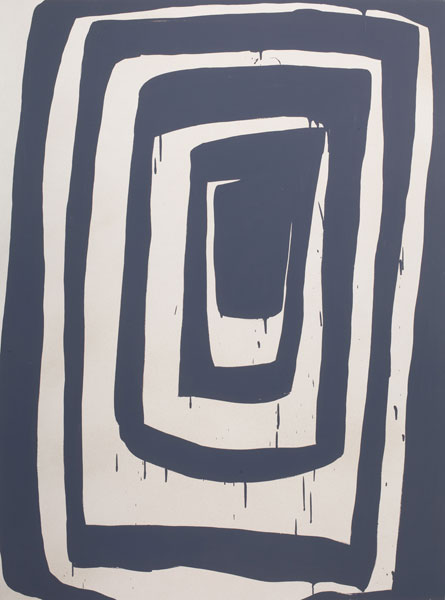
March 26, 2013

In or Outer, acrylic on canvas, 60 x 44'
Amy Feldman @ Gregory Lind
Amy Feldman's large-scale paintings appear, at first glance, like expanded napkin doodles. They're flatly painted, quickly executed and awkward, and for those reasons you might dismiss them. That, however, would be a mistake because Feldman wields some serious mojo. Her highly elastic forms, which veer from wackily geometric to ecstatically biomorphic, give shape to the notion of things being altered by unfamiliar forces.
The last time I experienced a sensation like this was with the German sculptor Ewerdt Hilgemann; he builds metal boxes from which he literally vacuums out the air, making them implode, literally, with a sharp bang. Feldman conjures similar sensations - but with an off-kilter Ellsworth Kelly-meets-Robert Crumb sensibility, and no hint of violence. Her works are the product of joyful, intensely physical, whole-body gestures. Not of the old-school variety now shunned by younger painters, but those of a certain unaligned faction of abstract painters untainted by rigid ideas about how pictures are supposed to be made. So instead of swinging for the fences, Feldman pursues more mundane impulses. Her paintings start from corner-of-the eye glimpses of studio detritus or from visions of the blight outside her window, but end considerably transformed.
Stephen Westfall, in a catalog essay that accompanied a recent show of Feldman's in New York, noted that the artist's Brooklyn studio lies close to the elevated portion of the F Train, near the Gowanus Canal, which, if you know the place, speaks volumes about some of the choices she's made. The most obvious has to do with color. She uses a drab shade of battleship gray, which varies slightly from painting to painting. She applies it with abandon, with no apparent care about success or failure, and that confidence is exhilarating; more so once you recognize the degree of control she exercises. Another factor that contributes to the success of these paintings is humor. Most of her works are flecked with drips that remind me of Philip Guston in his Poor Richard phase.
Feldman's main gambit, however, is subverting the rectilinear conventions of painted, pictorial space. She builds her forms with wavy lines that sit at odd angles to the edges of the paintings, which, in turn, set up an uneasy dialog between positive and negative space and between the shapes that appear at the outer edges. Works that immediately caught my eye were In or Outer, Ohm Home and Squared Up. The first features interlocking rectangles that recede into the picture plane; the second has a trio of stalagmites/stalactites interacting with a pair of warped parallelograms. The third combines a frenzy of circular gestures in a juicy, pulsating mass. Descriptions of this sort don't do justice to these pictures' dislocating physical impact. They are to painting what Harold Lloyd is to physical comedy: exemplars of the well-executed pratfall, tempting fate, but landing on one's feet.